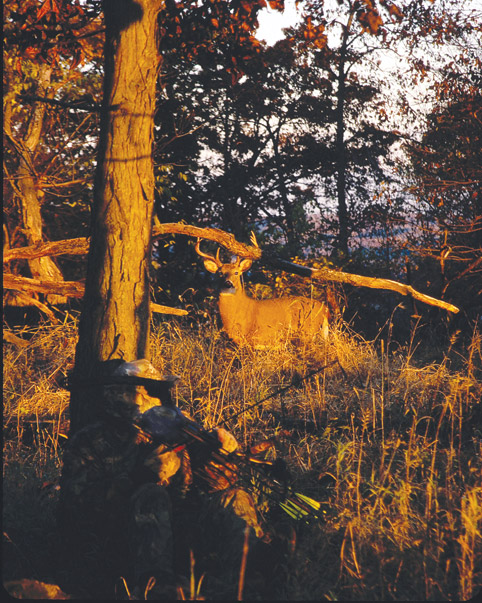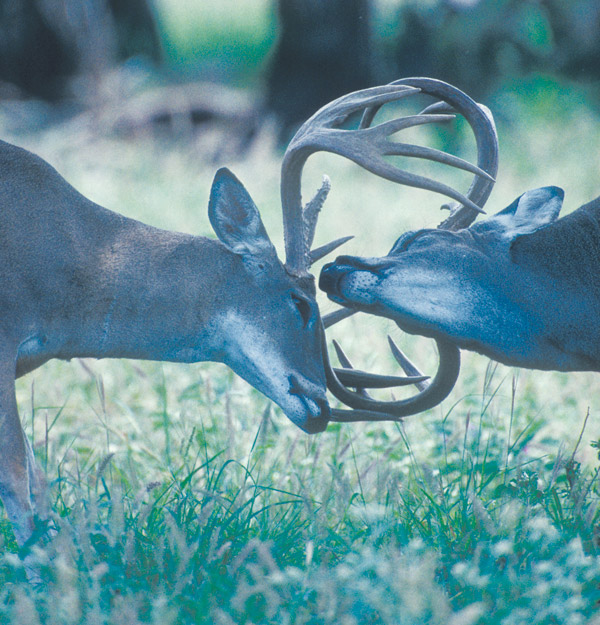 Deer Hunting: Calling Deer Before the Rut
Deer Hunting: Calling Deer Before the Rut
By Judd Cooney

I felt a bit like the guy who found himself butt deep in alligators when his intent was simply to drain the swamp. My original plan had been to call up some of the coyotes roaming my Iowa whitetail hunting leases and thin the population a bit while they were still gullible and before my first bowhunting clients started arriving later in October.
However, as often happens when dealing with unpredictable critters, the best laid plans may not pan out as expected.
I was using a Burnham brothers Black Magic mouth-blown call, given to me by Murry Burnham. The squalls closely imitate the distress sounds of a fawn deer, and those Iowa coyotes had shown a definite propensity for killing the fawns roaming my leases. I figured to get some satisfaction conning one with fawn bleats.
I was set up at the edge of a 10-acre CRP field surrounded by timbered slopes. The early morning sun was at my back and an almost imperceptible northeasterly breeze in my face. With a boggy creek bottom right at my back, I figured any responding predator would cross the opening in front, giving me a shot.
I was pushing air through the call for the second time when an irate doe came out of the creek bottom and stood 50 yards away, snorting and stomping. I muffled the volume of the call and increased the intensity. The doe stiff-legged toward me with hair standing on end and ears laid back, ready for a fight.
The doe was maybe 50 yards away when a big dog coyote bolted out of the woods at 200 yards, headed my way and also obviously intent on getting to the distressed fawn, if for other reasons. Fortunately for me, but not for the coyote, my .22-250 was pointed in the right direction and I only had to move a slight bit to get the coyote in the scope and keep it there. When it finally noticed the doe and stopped to eyeball her, I pulled the trigger, and a 52-grain Sierra hollow point boattail ended any thoughts that coyote might have ever again had about fresh deer meat.
The following morning, on another lease, a nicely antlered buck trotted to within 30 yards in response to fawn bleats, just as agitated as the doe had been the previous morning.
Didn’t get a coyote on that stand, but the response certainly reinforced the idea that fawn bleats could be an effective call for deer during the early season. Since those first encounters long ago, myself, my hunting compadres and my clients have taken a number of deer, both bucks and does, calling before the rut.
Many states open their whitetail seasons before conditions are ideal for deer hunting. With visibility hindered by heavy cover of one type or another, crops still unharvested in the fields, and lackadaisical daytime deer activity, early fall hunting can be an iffy proposition.
This is why a high percentage of hunters skip the early seasons and plan their hunts for later in the fall, for when the deer are more visible and the bucks supposedly more responsive to rattling and calling. This mindset often means less hunting pressure in the early season when the deer haven’t yet been “educated” by the unwashed masses tromping around the woods and fields. Who could ask for more?
As an outfitter and fervent whitetail hunter, I’m fortunate to be in the field from the first of the season to the last, through rain, shine or minus-45 cold, as occurred during this past year’s late season. This exposure to whitetails under every imaginable condition and situation has given a lot of opportunity to observe and experiment with off-the-wall techniques, as well as to fine-tune the standard tactics.
I find that deer respond to fawn distress or lost fawn calls, to soft doe grunts and bleats, to subtle rattling and scraping in the early season. With all of the weeds, crops and brush still blocking sight lines, it only makes sense to expand your perimeter with calling, to con the deer into coming to you rather than trying to find them. Subtlety and perseverance are the keys.
I like to get back to Iowa early in October, several weeks before the first bowhunters arrive. This gives me plenty of time to get camp in shape, to check out the local deer and hopefully take some good photos. During this time, I’ve watched excited does leave their own fawns and cross several hundred yards of open field to locate the source of fawn distress bleats and bawls. I’ve watched bucks follow those does and also respond on their own, often approaching within bow range.
My favorite fawn distress/bawl call is still the Burnham Black Magic. It works for coyotes, bears, whitetails, mule deer and blacktails.
Several years ago, I hunted the Missouri gun season in mid-November. The weather was unseasonably warm, and the trees still in full foliage. The pre-rut hadn’t really gotten started, and most of the bucks were nocturnal.
Despite the unseasonable weather, on opening day, the 140-acre field of waist-high weeds I was hunting appeared to be completely surrounded by blaze orange as rifle-toting neighbors took to the woods.
Three times that morning, I watched bucks enter the chunk of real estate I was overlooking, obviously spooked. Two of the bucks, both respectable eight points, came within 100 yards in response to fawn bleats and low-intensity doe bleats. The third, a 145-class bruiser, I coaxed out of a small patch of timber by tickling rattling antlers and scraping them up and down the tree that supported my stand. It took almost two hours for that buck to cover 200 yards as it came to an abrupt halt at every gunshot, and there were plenty of them. I’d alternate grunting softly and rattling lightly every 15 minutes. The buck finally ended up within 30 yards of my stand. I passed on the shot, figuring it was opening day and I would get more opportunities.
Later that morning, a monster buck appeared beside a large pond some 400 yards away. The wind had picked up enough to eliminate any chance of low-volume grunts, bawls and antler tickling reaching that far, and had it been a couple of weeks later, I would have pumped up the volume. However, I’ve learned it is very easy to overcall early in the season.
I curbed my impatience and watched the buck disappear into the heavy brush bordering the pond, most likely headed for a bed or sanctuary at the upper end. My subtle attempts to cajole the buck around the end of the lake did bring in a couple more small bucks from directly downwind.
The following morning, long before daylight, I was situated in the same tree waiting for the big buck’s appearance. When there was good shooting light, I grunted softly several times and then remained silent to see what might transpire. I couldn’t believe the amount of shooting I heard and wondered if there would be a live deer left in that part of Missouri.
I waited my usual 20 minutes and then grunted a couple times more and scraped the rattling antlers up and down the tree in imitation of a buck making a rub—a subtle yet extremely effective sound during the early season.
A few minutes later, a different “shooter” with a whole headful of antlers edged out of the dense brush and trees bordering the pond, scanning the open field trying to locate the source of the sound. At 200 yards, the standing deer presented an easy shot. The buck wasn’t as big as the one I’d seen the previous day but still scored 175 points.
Deer that have been spooked out of their core areas by other hunters are prime candidates for calling that piques their curiosity or arouses their instinct for companionship. Whether you are sitting along a fence line travelway, ensconced in a tree stand or ground blind, judicious calling can increase your effective hunting radius immensely, a fact often overlooked by most early season hunters.
When I started experimenting with deer calls early in the season, the last thing I wanted to do was educate the deer on my leases and make them tougher for clients to hunt later in the season. I was very careful with the calling and learned that subtlety is most effective early in the season. The instant a deer started to respond, I’d shut down, figuring to leave them wondering rather than take a chance on educating them to the source of such sounds. Didn’t take long to realize that once I caught their interest with minimal calling, they’d eventually end up within range if I just waited them out. Deer don’t have a schedule and can be very blase about their response to calling.

In addition to the bleats, bawls and grunts, soft antler rattling or more accurately antler rubbing and tickling can be very effective. During the early season, I never rattle at full intensity. Bucks at this time of year are curious but not overly aggressive, more likely to check out tentative sparring or rubbing than the sounds of an all-out fight.
Simply rubbing and scraping antlers up and down a tree trunk, or through the brush (something you can’t accomplish with a rattling bag), is effective at piquing an early season buck’s curiosity. When actually rattling, I tickle the antler tips together in a fairly rapid staccato of light sound, trying to imitate a couple of bucks in a friendly sparring match.
When a responding buck’s attention begins to wane, carefully scraping a tree trunk may hold it a little longer. Drives the bucks nuts when they can’t locate the deer making the racket. Will also bring in curious does.
I’m always surprised when veteran deer hunters tell me they rarely use calls, and then only during the rut. Calling in the early season can definitely increase the odds of getting a shot at a buck or a nice doe.